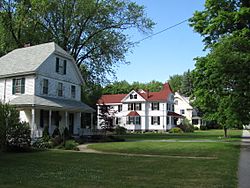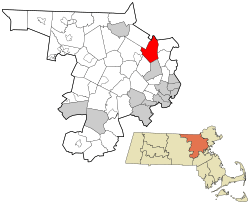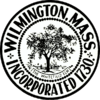Wilmington, Massachusetts facts for kids
Quick facts for kids
Wilmington, Massachusetts
|
||
|---|---|---|

Church Street
|
||
|
||
| Nickname(s):
Wilmy
|
||

Location in Middlesex County in Massachusetts
|
||
| Country | ||
| State | ||
| County | Middlesex | |
| Region | New England | |
| Settled | 1665 | |
| Incorporated | 1730 | |
| Named for | Spencer Compton, 1st Earl of Wilmington | |
| Government | ||
| • Type | Open town meeting | |
| Area | ||
| • Total | 44.6 km2 (17.2 sq mi) | |
| • Land | 44.4 km2 (17.1 sq mi) | |
| • Water | 0.2 km2 (0.1 sq mi) | |
| Elevation | 29 m (96 ft) | |
| Population
(2020)
|
||
| • Total | 23,349 | |
| • Density | 523.5/km2 (1,358/sq mi) | |
| Time zone | UTC−5 (Eastern) | |
| • Summer (DST) | UTC−4 (Eastern) | |
| ZIP Code |
01887
|
|
| Area code(s) | 978 | |
| FIPS code | 25-80230 | |
| GNIS feature ID | 0618246 | |
| Website | www.wilmingtonma.gov | |
Wilmington is a lively town in Middlesex County, Massachusetts, United States. It's home to over 23,000 people. Wilmington is known for its rich history and community spirit. It's a great place to live, learn, and explore!
Contents
History of Wilmington
Wilmington was first settled way back in 1665. It officially became a town in 1730. This happened when parts of nearby towns like Woburn, Reading, and Billerica joined together.
Some of the first settlers were Will Butter, Richard Harnden, and Abraham Jaquith. Will Butter was a Scottish Covenanter who fought in the English Civil Wars. He came to Woburn as a captive but later gained his freedom. He then moved to what is now Wilmington.
Wilmington and the American Revolution
When the American Revolution began, brave Minutemen from Wilmington were ready. On April 19, 1775, they quickly responded to the alarm. They fought in Concord at a place called Merriam's Corner.
Canals and Railroads
The Middlesex Canal was an important waterway that passed through Wilmington. It was built in the early 1800s. This canal helped move goods and people between the Merrimack River and Boston. Hops, a plant used in brewing, was a major cargo. Massachusetts was a top producer of hops back then.
When the city of Lowell grew in the 1820s, the canal became key. It transported cotton to and from the mills. However, the canal was no longer needed after the Boston and Lowell Railroad was built in 1835. The Boston and Lowell Railroad is still the oldest operating rail line in the U.S. today!
Local Discoveries and Landmarks
Wilmington is famous for being the place where the Baldwin apple was discovered. This popular apple variety started right here.
The Col. Joshua Harnden Tavern is another historic spot. It might have been a stop on the Underground Railroad. This was a secret network that helped enslaved people find freedom. Today, the tavern is the Wilmington Town Museum.
Since World War II, Wilmington has grown a lot. Major roads like Interstate 93, Route 62, Route 129, and Route 38 now run through the town.
Wilmington's Geography
Wilmington is located at 42°33′N 71°10′W / 42.550°N 71.167°W. It covers about 17.2 square miles (44.6 square kilometers). Most of this area is land, with a small amount of water.
Wilmington shares its borders with several other towns. These include Andover, North Reading, and Billerica. The town also has different areas, like Silver Lake and North Wilmington.
Much of Wilmington was built on or near wetlands. The Ipswich River actually starts in Wilmington. The Shawsheen River forms part of the town's border with Billerica.
Silver Lake
There is one beautiful lake in town called Silver Lake. It's a special type of lake called a kettle lake. These lakes formed when Pleistocene glaciers melted at the end of the last ice age. Silver Lake is a popular spot for swimming during the summer.
Climate in Wilmington
Wilmington, Massachusetts, experiences all four seasons. Temperatures usually drop below 50 degrees Fahrenheit for about 195 days each year.
The town gets a good amount of rain, about 44.4 inches per year. Snow covers the ground for about 62 days each year. The humidity is usually comfortable, staying below 60% for most of the year.
Wilmington's Population
Wilmington has grown quite a bit over the years. In 2020, the population was 23,349 people.
| Historical population | ||
|---|---|---|
| Year | Pop. | ±% |
| 1850 | 874 | — |
| 1860 | 919 | +5.1% |
| 1870 | 866 | −5.8% |
| 1880 | 933 | +7.7% |
| 1890 | 1,213 | +30.0% |
| 1900 | 1,596 | +31.6% |
| 1910 | 1,858 | +16.4% |
| 1920 | 2,581 | +38.9% |
| 1930 | 4,013 | +55.5% |
| 1940 | 4,645 | +15.7% |
| 1950 | 7,039 | +51.5% |
| 1960 | 12,475 | +77.2% |
| 1970 | 17,102 | +37.1% |
| 1980 | 17,471 | +2.2% |
| 1990 | 17,651 | +1.0% |
| 2000 | 21,363 | +21.0% |
| 2010 | 22,325 | +4.5% |
| 2020 | 23,349 | +4.6% |
| * = population estimate. Source: United States Census records and Population Estimates Program data. |
||
According to the 2000 census, there were 21,363 people living in Wilmington. Most residents were White (96.31%). About 2.03% were Asian, and 0.41% were Black or African American.
Many households in Wilmington have children under 18 (41.5%). Most families are married couples living together (69.6%). The average household had 3 people, and the average family had 3.33 people.
The median age in town was 36 years old. This means half the people were younger than 36, and half were older.
Education in Wilmington
Wilmington has its own school system for students of all ages.
- Younger students attend Wildwood Street and Boutwell Street Schools for Kindergarten.
- Grades 1-3 go to Woburn Street School and Shawsheen School.
- Grades 4 and 5 attend North Intermediate School and West Intermediate School.
- Grades 6-8 go to Wilmington Middle School.
- High school students attend Wilmington High School.
The mascot for Wilmington High is the wildcat. Their sports teams play in the Essex League. The Wildcats' colors are Navy Blue, Columbia Blue, and White. Their main rivals are the Tewksbury Redmen.
Wilmington also has a private school, Abundant Life Christian School, for Pre-K through 8th grade. Students can also choose to attend Shawsheen Technical High School for vocational training.
Wilmington's Economy
Wilmington is home to several important companies. These businesses provide many jobs for the community. Some of the companies based here include:
- Analog Devices
- Charles River Laboratories
- Onto Innovation
- UniFirst
Fun Places to Visit in Wilmington
Wilmington has many parks and fun places for everyone to enjoy.
- The Wilmington Town Common and Rotary Park: These are in the center of town. They are great spots for relaxing and community events.
- Parks and Recreation Facilities: You'll find many parks with walking paths, soccer fields, and baseball diamonds.
- Shriners Auditorium: This large indoor arena can seat 2,650 people. It's home to the Boston Roller Derby team.
- Silver Lake: The lake has a Town Beach, a playground, Fullerton Park, and Landry Park. It's perfect for a summer day.
- Ristuccia Ice Arena: This was once the practice rink for the Boston Bruins hockey team. You can also take lessons here.
- The Baldwin Apple Monument: Located on Chestnut St., this monument marks where the first Baldwin apple tree grew.
- The Wilmington Memorial Library: A great place to find books, learn, and connect with the community.
- Yentile Farm Recreational Facility: A big public park with lots of space for fun activities.
Getting Around Wilmington
Wilmington has good transportation options, especially by train.
- MBTA Commuter Rail: The town has two train stations.
- Wilmington Station is in the town center on the Lowell Commuter Rail Line.
- North Wilmington Station is two miles east on the Haverhill Commuter Rail Line.
- Both stations are near Route 62. A train ride to Boston's North Station takes about 28 minutes from Wilmington Station. It takes about 41 minutes from North Wilmington Station.
There are also bus services available:
- MBTA Bus Route 134: This bus stops near Wilmington's southern border. It connects to Wellington Station in Medford, where you can catch Orange Line subway trains.
- Lowell Regional Transit Authority Bus Route 12: This bus provides service from Wilmington Station to the Charles A. Gallagher Transit Terminal in Lowell.
Famous People from Wilmington
Many notable people have connections to Wilmington. Here are a few:
- Jason Bere: A former MLB pitcher and an American League All-Star.
- Ryland Blackinton: A guitarist for the band Cobra Starship.
- Dudley Allen Buck: An inventor known for the cryotron and content-addressable memory.
- Sean Collier: A police officer at MIT who was killed in 2013.
- Mike Esposito: A running back and kick returner for the Atlanta Falcons.
- Keith Gill: A retail investor famous for his role in the GameStop short squeeze.
- Gen. Henry Harnden: A Civil War officer.
- David G. Hartwell: A well-known science-fiction editor.
- Ezra Otis Kendall: A professor of mathematics and astronomy.
- Benjamin Thompson, Jr., Count Rumford: A scientist who taught school in Wilmington.
- Sears Cook Walker: A 19th-century astronomer.
- Timothy Walker: A noted 19th-century jurist and founder of Cincinnati Law School.
- Phillis Wheatley: The first published African-American poet.
See also
 In Spanish: Wilmington (Massachusetts) para niños
In Spanish: Wilmington (Massachusetts) para niños


